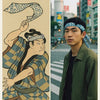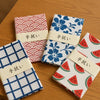What is a tenugui? - History, meaning and application
What is a tenugui?
A Tenugui (手拭い) is a traditional Japanese cotton cloth. It measures approximately 35 by 90 centimeters, has raw edges, and is particularly lightweight and quick-drying. Its roots date back to the Heian period, where it was used in ceremonies. By the Edo period, it was widely used in everyday life—among actors, artisans, merchants, and even samurai. It often bore personal symbols or family insignia.
To this day, Tenugui is still made in small workshops in Japan, using traditional dyeing techniques such as Chusen or Wet The color is not just applied superficially, but rather penetrated deep into the fabric. The result: the front and back look almost identical. This quality is rare and makes each tenugui a small work of art.

How do you use a tenugui?
Tenugui is versatile. It is traditionally worn in everyday life, for sports, at work, or even as a gift. Here are some examples:
- As a headband or scarf
- For drying hands or face
- As gift wrapping
- As a table runner or wall decoration
- As a light tea towel or tea towel
Tenugui are absorbent, hygienic, easy to clean, and require minimal space. The variety of motifs ranges from classic depictions of nature to humorous scenes or seasonal themes.
If you want to know how I found Tenugui, you can find my personal experience report here:
→ How I discovered Tenugui and why they stayed






Ich habe diese Tücher bei meinem Japan-Urlaub entdeckt und war sofort begeistert. Umso schöner, dass es jetzt auch eine Möglichkeit gibt, sie hier in Österreich zu bekommen. Vielen lieben Dank dafür und alles Gute für euren Shop!